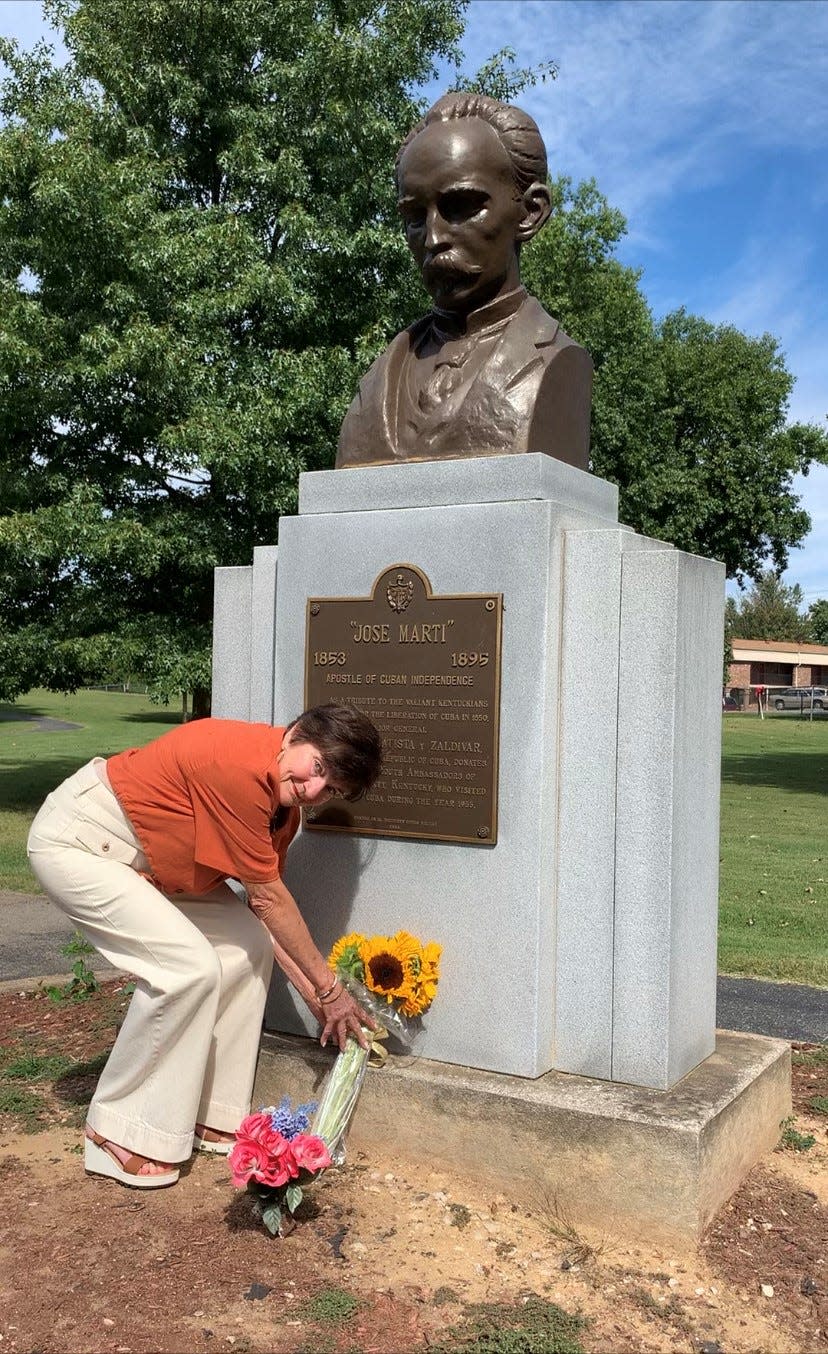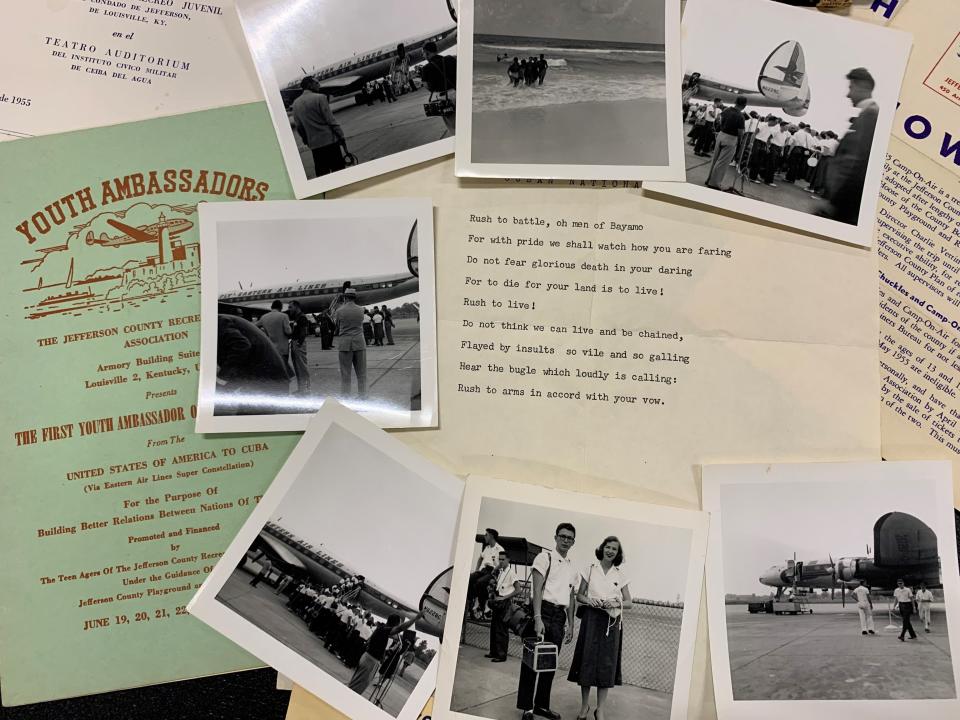How a trip 67 years ago created 'the most Cuban corner of the state' in Shively
- Oops!Something went wrong.Please try again later.
The three women hadn’t seen each other in 67 years. But on a warm fall day, Lucie Hoffman Schulz, Sally Elder and Linda Robinson Painter reunited to remember their trip to Cuba in 1955. They were part of the Jefferson County Youth Ambassador group that brought the bust of Cuban hero José Martí to Shively Park.
It all started with the Courier Journal Mobile Newsroom. We set up in Shively City Hall for the month of July looking to learn more about this community in the South End of Louisville. I was immediately drawn to the bust of José Martí, and wondered how the apostle of Cuban independence, the man who is considered the highest symbol of the Cuban homeland ended up in Shively Park.
To understand I had to go back 75 years to where it all began.
Youth ambassadors
In the 1940s, Jefferson County organized county-wide recreation with the motto of “Proper play keeps trouble away.” The robust youth programming included 34 indoor recreation centers and 30 playgrounds along with teen clubs, arts and craft programs, drama, dance classes, music lessons and sports.
Charlie Vettiner, the Jefferson County recreation director at the time had even bigger dreams ― to put the programming together with ambassadorship in mind. He first organized the annual Camp-On-Tour to the Great Smoky Mountains from 1949-1952, financed and performed by teenagers. County youth applied and raised funds to participate. The result was a production of singers, dancers and musicians. They called it “Chuckles.” In 1953 and 1954, the teenagers also put a showboat production on the Ohio River. But Vettiner’s ultimate dream was international.
More:'Culture is … who you are.' How Kentucky's Latinx creatives are merging art and heritage
Next stop, Havana
In the 1940s and 50s, Cuba was America’s playground for the wealthy. So perhaps when The County Recreation Youth Association chose Cuba for its first international Camp-On-Air trip, it didn’t seem so far-fetched of an idea. From thousands of applications, they selected 85 Jefferson County teenagers.
After learning of the trip, I published a column hoping to find anyone who may have gone so I could learn more. I heard from three. Lucie Hoffman Schulz and Sally Elder were dancers and both still living in Louisville. Linda Robinson Painter was a singer and living in Knoxville, Tennessee. Her sister read the column and told her to contact us. Each had applied and were accepted to be part of “Chuckles of 1955" in Cuba.
For children, by children
Youth ambassadors took handmade gifts with them to Cuba and presented a bronze plaque to President Fulgencio Batista to commemorate their "Youth Ambassador Good Will Flight." They also performed “Chuckles” for the president and met with Cuban children who in turn had a special gift for them.
Dr. Gustavo Adolfo Bock was the general director of Cuba’s Civico Militar, which operated five schools in which 4,300 orphan students were given a high school education and training in a trade. The children had cast a bust of José Martí and a bronze tablet themselves. Both were given to The Jefferson County Youth Ambassadors as a gift.
Later that summer, 500 people attended the unveiling in Shively Park on Friday, August 12, 1955. The Cuban delegation in attendance included Dr. Bock, instructors from the Civico Militar, 12 Cuban students and Edmund Chester, a former Courier Journal reporter who went on to advise President Fulgencio Batista.

When we met in Shively Park last month, Schulz brought sunflowers to set at the base of José Martí’s bust just like they had done in Cuba all those years ago. As part of their trip, the ambassador group visited the statue of José Martí in Havana's Central Park in Havana to place flowers.
After taking photos together with the bust, the women gathered in Shively City Hall to share memorabilia and enjoy Cuban pastries from Sweet Havana. Lucie Hoffman Schulz still has the earrings she bought in Cuba. She remembers wearing them to her prom. Linda Robinson Painter brought the handkerchief she had bought in Cuba for her mother who had pinned a hand-written note to it so she would remember where it came from. Sally Elder managed to save everything ― from her application to go on the trip, newspaper clippings in both English and Spanish, the event programs from both Cuba and Shively and even the meal card that showed what they ate on the plane ― she had it all. Elder credits her mother for saving everything.
There was still another meaningful addition to this reunion. Luis David Fuentes, the publisher of Kentucky’s Cuban magazine El Kentubano was also there. Rarely do we get the chance to understand how our experiences have rippled into the future to affect the next generation. But Fuentes helped these three women from Louisville do just that.

Opinion:Louisville's Cuban population is growing. Here are 2 refugees' stories of triumph
A special place
In 2009, Fuentes got a call about the José Martí bust. The Shively mayor had found it in really bad shape. Fuentes helped the city organize a fundraiser to have the bust restored. Then, on July 21, 2012, Mayor Sherry Conner declared the day José Martí Day in Shively and the community came together for a rededication ceremony, returning the bust to a prominent spot in Shively Park.
In the past ten years the bust in Shively Park has become a special place for local Cubans.
“This is the most Cuban corner of the whole state,” said Fuentes. “Every time we have an event or a commemoration or anything, the community comes here. It is our special place.”
Kentucky has a large Cuban population with Louisville being one of the top metropolitan areas in the country for Cuban immigrants.
It was the desire of the County Recreation Youth Association "to do something constructive in building better relations between this country and other nations,” the promotional flyer for the 1955 trip stated. But the trip offered something more. A gift from Cuba ― before Fidel Castro took over ― that would serve as a beacon of hope for Cubans arriving in Kentucky decades later.
“The bust of José Martí is a piece of Cuba in Kentucky,” Fuentes said. “He represents the freedom, love and prosperity that we do not have in Cuba, and we could find here in Kentucky, our second home. God bless the commonwealth!”
"It’s a beautiful thing," Lucie Hoffman Schulz said, “Little did we know on that August day in 1955 what the dedication of that bust would mean or its historical significance to the people of Cuba. I’m so happy for the Cuban people who immigrated to our state.”
Does Louisville have more spaces like Shively Park that hold special meaning for our immigrant communities? We’d love to know.
Bonnie Jean Feldkamp is the opinion editor. She can be reached via email at BFeldkamp@Gannett.com or on social media @WriterBonnie.
This article originally appeared on Louisville Courier Journal: José Martí bust in Shively, KY, a monument to international friendship

